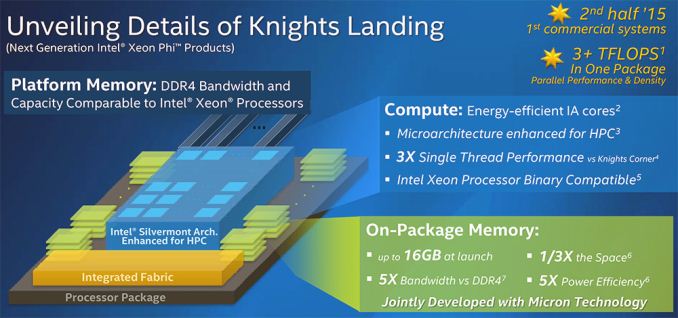Intel Begins EOL Plan for Xeon Phi 7200-Series ‘Knights Landing’ Host Processors
by Anton Shilov on July 24, 2018 11:10 AM EST- Posted in
- CPUs
- Intel
- Xeon Phi
- Knights Landing

Intel has initiated its product discontinuance plan for its Xeon Phi 7200-series processors codenamed Knights Landing (KNL). The said CPUs are used primarily for HPC applications, including supercomputers. As it appears, demand for these chips is not exactly great, which is why Intel does not see any reasons to keep producing them. At the same time, the company will keep offering its codenamed Knights Mill (KNM) solutions for Deep Learning.
Intel announced product discontinuance plan for the Xeon Phi 7210, 7210F, 7230, 7230F, 7250, 7250F, 7290, and 7290F processors on Monday. The process of their phasing out is not going to take long. The company’s customers are told to place their final orders on these CPUs by August 31, 2018. Meanwhile, the final products will be delivered by July 19, 2019.
As usual, Intel explained that “market demand for the products has shifted to other Intel products,” indicating that its Xeon Phi 7200-series processors in LGA3647-1 form-factor might not exactly popular among target customers in the technical computing space. The said processors feature from 64 to 72 HPC-enhanced Atom Silvermont cores that process up to four threads of code simultaneously and are outfitted with 16 GB of high-bandwidth MCDRAM memory. As for throughput, socketed Xeon Phi KNL processors offer 3-3.4 TFLOPS of double precision floating point (FP64) performance.
Intel announced the EOL plan for HPC-oriented many-core Xeon Phi 7200-series “Knights Landing” CPUs about 11 months after it decided not to release its Xeon Phi 7200-series coprocessor cards. The latter only offered performance of up to 3 TFLOPS FP64 and featured considerably more limited I/O options than their socketed counterparts: they only had 16 PCIe 3.0 lanes (vs. 36 lanes on CPUs) and they did not support Intel’s OmniPath fabric (unlike the Xeon Phi 7200F-series CPUs) that is particularly useful for supercomputer deployments. Meanwhile, since socketed Knights Landing CPUs do not support multi-processor configurations, the coprocessors cards could be used for density, which is crucially important for HPC applications. As it appears, Intel first decided to EOL KNL cards and eliminate their density advantage, but now it decided to discontinue even the processors, possibly because of low interest from potential customers.
| AVX-512 Support Propogation by Various Intel CPUs | ||||||
| Xeon, Core X | General | Xeon Phi | ||||
| Skylake-SP | AVX512BW AVX512DQ AVX512VL |
AVX512F AVX512CD |
AVX512ER AVX512PF |
Knights Landing | ||
| Cannon Lake | AVX512VBMI AVX512IFMA |
AVX512_4FMAPS AVX512_4VNNIW |
Knights Mill | |||
| Ice Lake | AVX512_VNNI AVX512_VBMI2 AVX512_BITALG AVX512+VAES AVX512+GFNI AVX512+VPCLMULQDQ |
AVX512_VPOPCNTDQ | ||||
| Source: Intel Architecture Instruction Set Extensions and Future Features Programming Reference (pages 12 and 13) Bold: Supported by Knights Landing |
||||||
The discontinuance of Intel’s Xeon Phi 7200-series Knights Landing CPUs does not mean the end of the road for the product family in general. Intel will continue to offer its Xeon Phi 7235/7285/7295 “Knights Mill” CPUs optimized for Deep Learning applications, but featuring a lot of similarities with the Knights Landing. Nonetheless, with the cancellation of Knights Hill and obvious problems with Intel’s 10 nm process technology, it looks like the company will not have a competitive Xeon Phi product for the HPC market for quite some time.
Related Reading
- Intel Discontinues Xeon Phi 7200-Series ‘Knights Landing’ Coprocessor Cards
- Intel’s "Knights Landing" Xeon Phi Coprocessor Detailed
- Intel @ SC15: Launching Xeon Phi “Knights Landing” & Omni-Path Architecture
- SuperComputing 15: Intel’s Knights Landing / Xeon Phi Silicon on Display
- Intel Lists Knights Mill Xeon Phi on ARK: Up to 72 cores at 320W with QFMA and VNNI
- Intel Announces Knights Mill: A Xeon Phi For Deep Learning
Source: Intel












23 Comments
View All Comments
Jaybus - Saturday, July 28, 2018 - link
I think the major difference is that KNL is a processor, not a co-processor or accelerator. It is an excellent idea, but it just turns out, at least for now, that it cannot beat CPUs in combination with accelerators. If accelerators are to be used anyway, then its cheaper and easier to use general-purpose CPUs.iwod - Wednesday, July 25, 2018 - link
So Knights Mill is the Kabylake or Coffeelake of Skylake. What exactly is the big deal EOLing an earlier processors? Am I missing something obvious?edzieba - Wednesday, July 25, 2018 - link
Not a bad lifetime for a chip that debuted in 2013. It had a good run in HPC too, at its peak it had a 6% system share of the TOP500 (https://www.top500.org/statistics/details/accelfam... beating out every accelerator other than Nvidia GPUs. P100 and V100 quickly assumed total dominance in that space after release though.